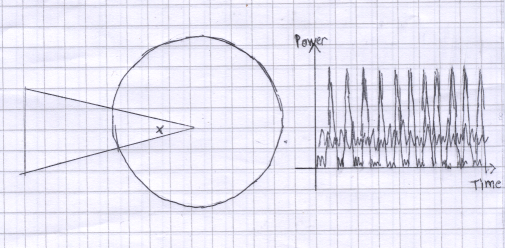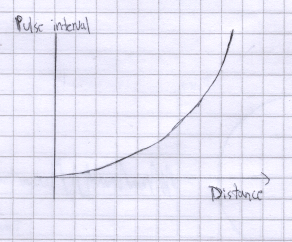










Written 28.11.2008 - Uploaded 09.05.2009 - PDF (contains entire design document)
This game mechanics document, along with other parts of the design document, was written for a course project at the university. This design was ultimately turned into a prototype, implemented as a Half-Life 2 mod. I have no idea about the mods availability, but we got pretty high marks from the course (4 out of 5). Remnants of Reality is a horror game that focuses around sound.
---
Extra-sensory noise perception
This section aims at clarifying the noise sense of the protagonist. In order to detect his invisible foes, the protagonist has two different kinds of senses. Both of these senses produce noise inside the protagonist's head in the proximity of monsters. Both senses have their own detection areas: the less specific sense detects monsters from a circular radius around the protagonist, while the more precise sense acts much like a direction microphone, generating pulses whenever a monster is exactly or almost directly ahead (see pictures below).
We'll start by introducing the static (static sense from now on). In the following picture, a monster is outside the protagonist's FOV. The noise produced inside the protagonist's head is shown in the graph to the right.

Chart 1: Active static sense
The static noise is relatively weak in power. In other words, the sense is highly vulnerable against external noise sources, making it hard for the player to hear this “warning signal” if there are noisy machines or other sources nearby. In such environments, the protagonist will be vulnerable against attacks from his sides and behind.
Currently I'd consider the static noise to have invariable power. If there is a monster within the sense's radius, then noise will be produced at the same volume. This puts more pressure on the player, because direction and distance cannot be measured from the static in any way. There might be a relatively sharp fadeout at the edge of the static sense area but that should be all.
The more accurate sense is presented by noise pulses. The range of this sense (pulse sense from now on) is longer than the radius of the static sense. This is shown in the charts 2 and 3.

Chart 2: Active pulse sense outside static sense radius

Chart 3: Active pulse sense inside static sense radius
As can be seen, the pulses are much more powerful than the static noise. Another thing worth noticing is the pulse interval which decreases as the monster becomes closer which allows the player to measure distance to some degree. Also, because of this, it is harder to notice a monster from afar because the pulse interval is relatively long; the monster needs to stay inside the pulse sense detection area until one pulse is produced. This way, by looking around quickly, the player may accidentally overlook a monster's position. On the other hand, when the monster gets close and panic ensues, pulses will come very frequently making the monster detectable on a rather quick look-around. Graph 1 illustrates this.

Graph 1: Pulse interval as a function of distance
If desired, the pulse sense could be modified to produce loudest pulses when the monster is directly ahead of the protagonist, and weaker pulses when the angle grows. If this is not technically too challenging, it sounds like a better option than to produce pulses at same volume.
One other thing should be noted as well: theses senses should penetrate walls and other obstacles to make them useful enough for the player. Of course, since we are mean, this can be used to create lots of false alarms from monster that can't really reach the protagonist.
As can be seen, there's no numerical data on the graphs yet. Suitable ranges for the senses can be decided at the implementation and testing. It is worth notice that the range is an important factor in level design, so it should still be decided relatively early on and keep fixed from that point on.
Bleeding light
As described in the mythology, the enemies in the game bleed light from their wounds as focused beams. In game terms, this is what makes it easier for the player to mark detected enemies in a way so that they can be perceived more quickly afterwards.
The intended system is relatively simple to describe. There is a core of light inside every creature and once they take damage from anything that'll make holes in their outer shell, a beam of light is projected through said hole, directly away from the core. The light's color can be fitted on the current atmosphere but should not be dependent on the species of enemy, as it is not in our intent to allow the player to recognize enemies.
In the prototype stage this can be demonstrated by an easier method of making the enemies glow some eerie light.